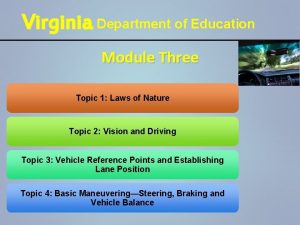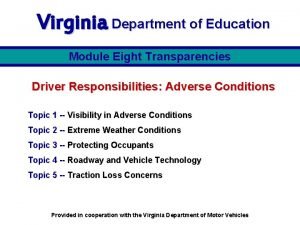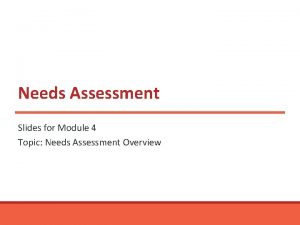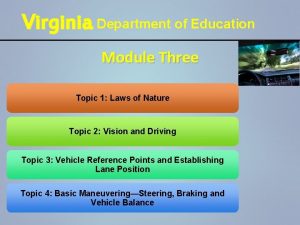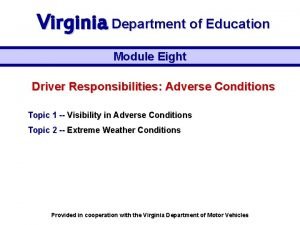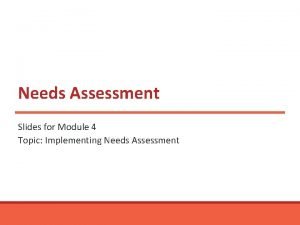Needs Assessment Slides for Module 4 Topic Needs


























- Slides: 26

Needs Assessment Slides for Module 4 Topic: Needs Assessment Data Provided by Recipient/Surveillance

Needs Assessment Data Provided by Recipient/Surveillance Epi Profile, Estimate of Unmet Need, and Estimate of PLWH Unaware of Their Status • • • Overview Legislative Requirements Epidemiologic Profile Estimate and Characteristics of PLWH with Unmet Need Estimate and Characteristics of PLWH who are Unaware of their Status Uses of Data Provided through the HIV Surveillance System

Training Objectives Following the training on needs assessment data provided by the recipient, participants will be able to: 1. Identify the needs assessment components for which the recipient/surveillance staff provide needed data 2. Explain the scope and use of an epidemiologic profile 3. Describe the concept and the importance of understanding “unmet need” 4. Describe why it is important to estimate the number and characteristics of PLWH who are unaware of their status

Overview of Needs Assessment Data Provided by Surveillance • Data for some key components of needs assessment are used by the PC/PB but not collected by the PC/PB – Includes the epidemiologic profile, estimate of unmet need, and estimate of number of PLWH who are unaware of their status • Data come from the Enhanced HIV/AIDS Reporting System (e. HARS), developed by the Centers for Disease Control and Prevention (CDC) and used by state and local health departments to monitor the HIV epidemic • Surveillance staff collect and can report information about key events from the time HIV infection is first diagnosed in a person until death

Legislative Requirements Related to Unmet Need & PLWH Unaware of Status 1 A. “determine the size and demographics of the population of individuals with HIV/AIDS, ” [epi profile and estimate/characteristics of PLWH with unmet need] “as well as the size and demographics of the estimated population of individuals with HIV/AIDS who are unaware of their HIV status” [estimate/characteristics of unaware PLWH] − 2009 Legislation, § 2602(b)(4)(A)

Legislative Requirements Related to Unmet Need & PLWH Unaware of Status 2 B. “determine the needs of such population, with HIV/AIDS, with particular attention to: i. individuals with HIV/AIDS who know their HIV status and are not receiving HIV-related services; … ii. individuals with HIV/AIDS who do not know their HIV status. ” − 2009 Legislation, § 2602(b)(4)(B)

Epidemiologic (Epi) Profile • Important overview of the epidemic in your EMA/TGA • Usually prepared by state or local surveillance staff – PC/PB should work with surveillance staff on data formats and any special information needs – Updated every year • Provides information about: – Current status of the local epidemic: number and characteristics of people diagnosed with HIV disease, overall and among specific subpopulations, including new cases (incidence), living cases (prevalence), and trends – Characteristics such as age, gender, race/ ethnicity, risk factor, and county/city of residence

Epidemiologic (Epi) Profile (cont. ) • Often includes: – Additional data to help understand recent trends, such as highincidence areas, subpopulations with increasing incidence, and late or delayed testing – HIV care continuum data – linkage to care, retention in care, and viral suppression – for all PLWH in the service area and also for all RWHAP clients, as well as for RWHAP subpopulations

Importance and Use of the Epi Profile • Provides an overall picture of HIV in the service area • Helps in identifying subpopulations and geographic areas with increasing rates of HIV – Enables recipient and PC/PB to develop or refine services to ensure appropriate care for emerging groups – For an integrated prevention and care PC/PB, helps in identifying target populations for primary prevention, testing, and prevention for HIV-positive individuals • Helps in identifying populations to target for special attention in assessment of PLWH service needs and barriers

Quick Activity A: Using Epidemiologic Data You have been working with local surveillance staff to identify special data needs for next year’s epi profile. The following have been suggested: 1. Subpopulation analysis of linkage to care to learn what groups of PLWH are most likely to delay entry into care after diagnosis, based on race/ethnicity, age, gender, & risk factor 2. Data on “late testers” – the percent of individuals with AIDS (Stage 3 HIV) when first diagnosed or within a year after diagnosis – How might the PC/PB use such data in decision making? – If you had to pick one of these, which would be more useful to your PC/PB? Why?

Estimate and Characteristics of PLWH with Unmet Need • Estimate of the number of people living with HIV in the jurisdiction who know their status but are not receiving HIVrelated medical care, including PLWH who: – Were not linked to care following diagnosis (delayed entry into care) – Were in care but dropped out • Characteristics of PLWH who are not in care

Unmet Need Terminology To avoid confusion, HRSA/HAB uses the following definitions: • Unmet need is “the unmet need for HIV-related medical care among individuals who know their status but are not receiving such care (not ‘in care’)” • Service gaps are “all service needs not currently being met for all PLWH except for primary health care for individuals who know their status but are not in care. Service gaps include additional need for health services for those already receiving HIV-related primary health care (‘in care’)” − Part A Manual, p 166

Responsibility for Estimating Unmet Need • Surveillance staff typically provide the estimate of unmet need and often characteristics of people with unmet need that are included in the surveillance database • PC/PB is responsible assessing service gaps and barriers for PLWH both in and out of care

Estimating Unmet Need • Several methods used for estimating unmet need, based on HIV surveillance and/or treatment data • Original method looks at the number of individuals living with HIV in the jurisdiction based on reported HIV/AIDS diagnoses, then finds out how many have evidence of 1 of the following during a defined 12 -month period: – CD 4 count – Viral load test – Prescription for antiretroviral medications • Individuals with none of these are assumed to have unmet need

Estimating Unmet Need (cont. ) • Second method based on HIV care continuum retention data an individual has unmet need if there is no evidence of 2 or more of the following, each performed at least 3 months apart in the measurement year: – 2 documented medical visits or – 2 viral load tests or – 2 CD 4 tests • As of 2018, HRSA/HAB was reviewing unmet need estimation methods

Characteristics of People with Unmet Need that May Be Available from HIV Surveillance • Demographic analysis: Who is out of care – age, gender, race/ethnicity, risk factor, other factors like gender identity, primary language • Geographic analysis: Differences in unmet need numbers or rates in various parts of the EMA or TGA • Populations of special interest: PLWH subpopulations with high rates of unmet need (e. g. , young MSM of color, transgender PLWH) • Care history: Review of past evidence of CD 4 counts or viral load tests in the surveillance system for people who are currently out of care (no recent lab tests), to learn about their history of involvement with the service system

Quick Activity B: Understanding Unmet Need As part of your assessment of service needs and gaps, your committee needs to locate and interview or survey PLWH with an unmet need for HIV-related primary medical care. The committee is discussing how to find people who are out of care. Your surveillance system just completed an estimate and profile of people with unmet need. • What information from surveillance about out-of-care PLWH might be especially helpful to the committee in finding people so you can assess their service needs and barriers?

Use of Unmet Need Estimate and Characteristics Data • Getting people with unmet need into care requires finding out who and where they are • Results are used by the PC/PB in other components of its needs assessment, to better understand why people are out of care and what services they need other than HIV-related medical care • Results of needs assessment include funding decisions that can help these PLWH enter or re-enter and remain in care

Estimate and Characteristics of PLWH who are Unaware of their Status • The approximate number or percent of people in the EMA or TGA who are HIV-positive but are unaware of their status • A sense of who these unaware individuals are and where they are most likely to live – Analysis of testing and epidemiologic data can provide an understanding of populations most likely to be undiagnosed – Descriptions in terms of their race/ethnicity, age, gender, risk factors, and places of residence

Estimating the Number & Characteristics of PLWH Unaware of their Status • CDC provides an estimate of the percent of all PLWH believed to be unaware of their status • Some states and localities do their own analysis based on surveillance data • Estimating the characteristics of people who do not know their status is, of course, challenging, but strategies exist to provide estimates – primarily through use of surveillance data

Surveillance-based Strategies for Estimating Characteristics of Unaware PLWH • Use epi data to estimate characteristics of unaware PLWH • Analyze characteristics of late testers over the past several years to see what groups seem most likely to delay testing – and to be HIV+/unaware – Late testers are people living with HIV who are not diagnosed until late in the course of HIV infection – Usually defined as people diagnosed with AIDS at the same time or within 1 year after their first HIV diagnosis • Analyze recently diagnosed PLWH to identify populations with increasing HIV incidence − Part A Manual, pp 187 -188

Surveillance-based Strategies for Estimating Characteristics of Unaware PLWH, cont. 1 • Do geomapping of recent cases to target locations likely to have large numbers of unaware PLWH – Use of geographic information systems (GIS) computer software to map recently reported cases of HIV by geographic location such as home address or zip code – Assumption is that places with high rates of newly diagnosed cases of HIV are likely to have high rates of undiagnosed cases as well • Identify areas with high community viral loads, where people are especially likely to be infected and out of care − Part A Manual, pp 187 -188 22

Surveillance-based Strategies for Estimating Characteristics of Unaware PLWH, cont. 2 • Do geomapping of recent cases to target locations likely to have large numbers of unaware PLWH – Use of geographic information systems (GIS) computer software to map recently reported cases of HIV by geographic location such as home address or zip code – Assumption is that places with high rates of newly diagnosed cases of HIV are likely to have high rates of undiagnosed cases as well • Identify areas with high community viral loads, where people are especially likely to be infected and out of care − Part A Manual, pp 187 -188

Quick Activity C: Importance of Data on Unaware PLWH Local surveillance staff did a special estimate of PLWH who are unaware of their status by race/ethnicity, age, and gender. The results indicated that young African American and Latino men are most likely to be unaware of their status and identified several geographic areas where unaware PLWH most likely live. • How might you use this information in planning the rest of your needs assessment, especially the assessment of service needs and barriers? • How might the PC/PB use this information in decision making about services and allocations?

Importance of Unmet Need and Individuals Unaware of their Status • It is very important to locate people unaware of their status or with unmet need, so they get tested, enter or re-enter HIVrelated primary medical care, obtain medications and other needed services, and become virally suppressed: • About 15% of PLWH in the U. S. were unaware of their status in 2015 – but 51% of PLWH aged 13 -24 (CDC) • About 49% of all PLWH were virally suppressed in 2015 (CDC) – compared to 85% of patients receiving RWHAP outpatient ambulatory health services (OAHS) in 2016 (HRSA/HAB) • Early treatment reduces the risk of HIV transmission by as much as 96% • Early and ongoing care key to good health

Sum Up • Epi profile, estimate of unmet need, and estimate of PLWH/unaware come to PC/PB from surveillance staff • Data help PC/PB better understand current epidemic • Epi data show trends that will affect service needs – For example: increase in new cases in a particular population or geographic location may require more or different services, or services in different locations • Unmet need/unaware data can show need for new service strategies; for example: – Increase in unmet need may require more funds for Early Intervention Services to re-link PLWH to care – Knowing where PLWH unaware of their status are concentrated helps target prevention and testing
 A small child slides down the four frictionless slides
A small child slides down the four frictionless slides A crane lowers a girder into place
A crane lowers a girder into place Clueing topic sentence
Clueing topic sentence Narrowing down a topic exercises
Narrowing down a topic exercises Drivers ed module 3 topic 1
Drivers ed module 3 topic 1 Curriculum guide for driver education in virginia module 10
Curriculum guide for driver education in virginia module 10 Module 7 topic 1
Module 7 topic 1 Module 5 topic 1 drivers ed
Module 5 topic 1 drivers ed Module 11 drivers ed virginia
Module 11 drivers ed virginia Module 8 topic 1
Module 8 topic 1 Module 4 topic 1 assessing and managing risk
Module 4 topic 1 assessing and managing risk Module 4 topic 1 assessing and managing risk
Module 4 topic 1 assessing and managing risk Module 4 topic 1
Module 4 topic 1 Module 2 topic 4
Module 2 topic 4 Module 4 topic 2 components of the space management system
Module 4 topic 2 components of the space management system Module 4 topic 5 turnabouts and parking
Module 4 topic 5 turnabouts and parking Module 3 topic 1 laws of nature
Module 3 topic 1 laws of nature Curriculum guide for driver education in virginia module 3
Curriculum guide for driver education in virginia module 3 Module 8 topic 1
Module 8 topic 1 Module 4 topic 1
Module 4 topic 1 C device module module 1
C device module module 1 Primary needs and secondary needs
Primary needs and secondary needs Primary needs and secondary needs
Primary needs and secondary needs Henry murray theory
Henry murray theory Strategic gender needs and practical gender needs
Strategic gender needs and practical gender needs Wants in esp
Wants in esp Authenticity principles of language assessment
Authenticity principles of language assessment




